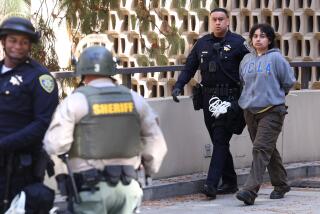BOOK MARK : A New Moral Majority Dictates an ‘Illiberal Education’ : BOOK REVIEW: “Illiberal Education: The Politics of Race and Sex on Campus,” by Dinesh D’Souza, is reviewed on Page 2 of today’s Book Review section.
Behind a banner of cultural pluralism and unchecked by their elders, many student activists, the author contends, promote ignorance and intolerance. An excerpt.
Many university presidents are not intellectual leaders but bureaucrats and managers; their interest, therefore, is not in meeting the activist argument but in deflecting it, by making the appropriate adjustments in the interest of stability.
When a debate over the canon erupts, university heads typically take refuge in silence or incomprehensibility; thus one Ivy League president responded to Allan Bloom’s book, “The Closing of the American Mind,” by saying that the purpose of liberal education was to “address the need for students to develop both a private self and a public self, and to find a way to have those selves converse with each other.”
Earlier incidents reveal the posture of Chancellor Ira Michael Heyman of Berkeley, and Presidents Donald Kennedy of Stanford, James Cheek of Howard, James Duderstadt of Michigan, Keith Brodie of Duke and Derek Bok of Harvard to be a curious mixture of pusillanimity, ideology and opportunism. At Stanford, Duke and Harvard, when minority groups, assisted by activist professors, urge the transformation of the curriculum toward a “race and gender” agenda, they face potential opposition from a large segment of faculty who may be sympathetic to minority causes but at the same time believe that the curriculum should not be ideologically apportioned. These dissenters are branded as bigots, sexists and homophobes, regardless of their previous political bona fides.
If minority faculty and student activists are not a numerical majority, they inevitably are a kind of Moral Majority, and they wield the formidable power to affix scarlet letters to their enemies. Few dare to frontally oppose the alliance between minority groups and faculty activists; most wrestle with their conscience and win, and even professors with qualms end up supporting curricular transformation with the view that change is inevitable.
The reason most people in authority at the university have such a difficult time with the canon lobby is that, while championing the principle of “representation” in admissions, they have acknowledged the indeterminancy of merit standards, the unreliability of standardized tests, the need to reform tests so that different groups fare equally, the inevitability of political considerations entering into the assignment of merit and so on. It seems a bit late in the day for college presidents, deans and professors to assert that the curriculum should be exempt from this egalitarian critique.
Moreover, most university leaders have no answer to the charge that the curriculum reflects a white male culture, and consequently embodies all the hateful prejudice that whites have leveled against other peoples throughout history. Nor can they explain why, if not for discrimination, minority students aren’t doing as well as other students.
Universities have insisted from the outset that standards have not been lowered, so why do black and Hispanic students fall behind if not for curricular racism? And won’t the rationing of books among different ethnic “perspectives” make an indispensable contribution to “diversity”?
Thus begins the process, already far advanced, of downplaying or expelling the core curriculum of Western classics in favor of a non-Western and minority-oriented agenda. Universities like Stanford, Berkeley and Harvard establish ethnic studies requirements, multicultural offerings, Afro-American Studies and Women’s Studies departments.
The typical rationale is that white professors cannot effectively communicate with, or provide role models for, minority students. This argument is somewhat transparent, since it relies on the premise that interracial identification is impossible, and no one has ever alleged that minority professors are racially or culturally disabled from teaching white students. College administrators will privately admit that “minority perspectives” is a pretext for meeting affirmative-action goals. The so-called “studies” programs also serve the purpose of attracting minority students who are having a difficult time with the “white” curriculum, but who feel at home in a department like Afro-American Studies.
What transpires in the “race and gender” curriculum is anything but “diverse.” Typically, these programs promulgate rigid political views on civil rights, feminism, homosexual rights and other issues pressed by activists who got these departments set up in the first place.
Thomas Short, a professor of philosophy at Kenyon College, observes, “ideological dogmatism is the norm, not the exception, in the ‘studies’ programs, especially women’s studies. Intimidation of non-feminists in the classroom is routine.” Short adds that, curiously, ideologues in these programs practice the very exclusion they claim to have suffered in the past.
Even if some faculty in the “race and gender” curriculum seek to promote authentic debate or intellectual diversity, this is difficult in an atmosphere where activist students profess to be deeply offended by views that fall outside the ideological circumference of their victim’s revolution. Once a professor finds himself the object of vilification and abuse for tackling a political taboo, others absorb the message and ensure that their own classes are appropriately deferential.
Although curricular and extracurricular concessions by the university greatly increase the power of minority activists, it is not clear they help minority students use knowledge and truth as weapons against ignorance and prejudice, nor that they assuage the problems of low morale and low self-esteem that propelled them in this direction to begin with.
Nor does an apparently more even “balance of power” between minority and non-minority students produce greater ethnic harmony. In fact, many minority students find themselves increasingly embittered and estranged during their college years, so that by the time they graduate they may be virtually isolated in a separatist culture, and espouse openly hostile sentiments against other groups.
At graduation time, it turns out that only a fraction of the minority students enrolled four years earlier are still around, and even among them the academic record is mixed: A good number (most are probably not affirmative-action beneficiaries) have performed well, but a majority conspicuously lag behind their colleagues and a sizable group has only finished by concentrating in congenial fields such as Afro-American or Ethnic Studies, under the direction of tolerant faculty advisers.
Relatively few of these students have developed to full potential over the four years, or have emerged ready to assume positions of responsibility and leadership in the new multiracial society.
1991 by Dinesh D’Souza, Reprinted with permission from The Free Press, a division of Macmillan, Inc.
More to Read
Sign up for our Book Club newsletter
Get the latest news, events and more from the Los Angeles Times Book Club, and help us get L.A. reading and talking.
You may occasionally receive promotional content from the Los Angeles Times.






